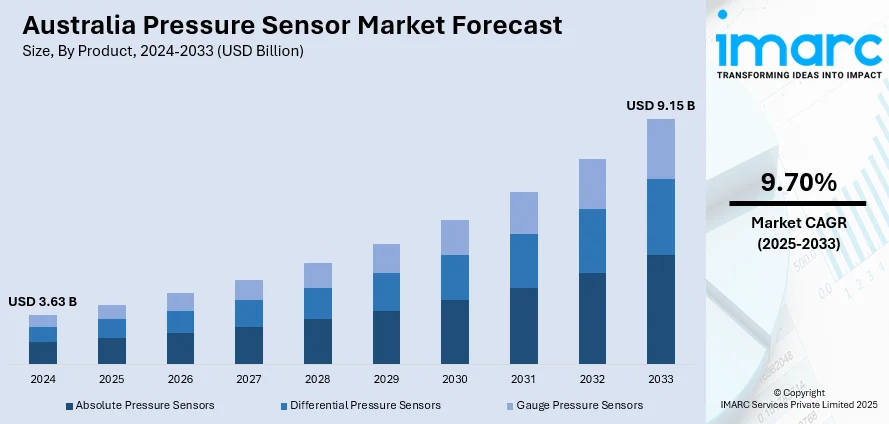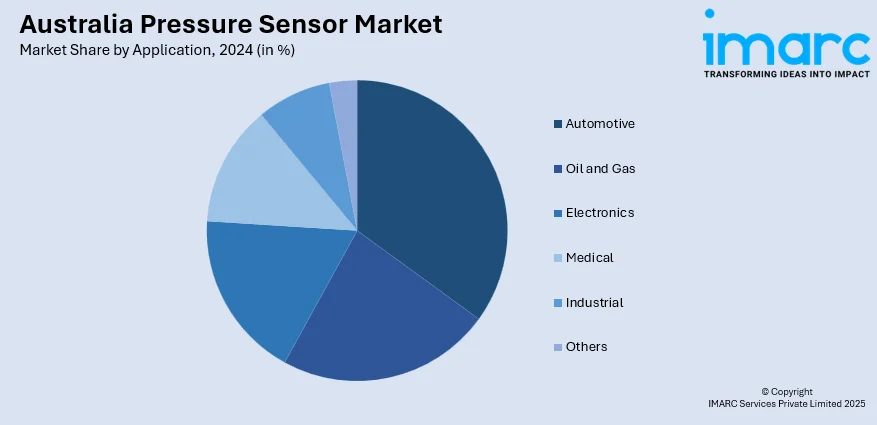
Australia Pressure Sensor Market Size, Share, Trends and Forecast by Product, Type, Technology, Application, and Region, 2025-2033
Australia Pressure Sensor Market Overview:
The Australia pressure sensor market size reached USD 3.63 Billion in 2024. Looking forward, IMARC Group expects the market to reach USD 9.15 Billion by 2033, exhibiting a growth rate (CAGR) of 9.70% during 2025-2033. The market is developing on the back of wireless technologies in industrial automation, increased use in healthcare applications, and rising integration in automotive electronics. The developments are also backed by the digitalization drive, patient-focused medical innovation, and green transportation in the country. With growing needs for precision and quality sensing across key industries, a consistent rise in Australia pressure sensor market share is projected.
|
Report Attribute
|
Key Statistics
|
|---|---|
|
Base Year
|
2024
|
|
Forecast Years
|
2025-2033
|
|
Historical Years
|
2019-2024
|
| Market Size in 2024 | USD 3.63 Billion |
| Market Forecast in 2033 | USD 9.15 Billion |
| Market Growth Rate 2025-2033 | 9.70% |
Australia Pressure Sensor Market Trends:
Integration of Wireless Sensor Technologies in Industrial Applications
Australia is undergoing a major transition towards the use of wireless pressure sensors, especially in process and industrial automation industries. Wireless systems are gradually substituting traditional wired setups because of their scalability, flexibility, and lower installation expense. As Australian industries update their infrastructure, wireless pressure sensors are providing real-time monitoring and data transfer, leading to improved operational efficiency. This trend is further being fueled by the increasing use of Internet of Things (IoT) platforms, where pressure sensors are the key to predictive maintenance and remote diagnosis. Amplified demand for intelligent manufacturing solutions has integrated wireless pressure sensors into Industry 4.0 strategies. Australia pressure sensor market growth, market size, and market forecast are likely to demonstrate continued momentum driven by government programs espousing industrial digitization and incremental phase-down of older systems in mining, energy, and heavy machinery industries.

To get more information on this market, Request Sample
Pressure Sensor Expansion in the Medical Industry
The Australia healthcare market is witnessing increased use of pressure sensors in both critical care monitoring and non-invasive monitoring platforms. From wearable health monitors to respiratory therapy units, pressure sensors are improving clinical outcomes and aiding patient diagnostics. The ageing population and growing chronic disease incidence have driven demand for smaller, more accurate, and reliable sensing technology in medical equipment. In addition, home healthcare solutions have become highly common, opening new space for pressure sensor applications in remote monitoring of patients. For example, in March 2025, WearOptimo launched an artificial intelligence (AI) powered wearable hydration patch in Australia, allowing real-time, non-invasive monitoring for mining, military, and sports industries prior to its scheduled 2027 release. Furthermore, this trend complements the overall digital health shift being pursued in Australia. Pressure sensing technologies are also being leveraged in surgery tools and robotic-assisted surgical procedures to promote safety and accuracy. Australia pressure sensor share show growth in the medical application category, fueled by advancements in microelectromechanical systems (MEMS) and patient-based healthcare models.
Increased Usage of Smart Sensors in Automotive Electronics
Pressure sensors are contributing significantly to the development of automotive electronics in Australia. With the nation embracing tighter environmental regulations and vehicle safety features, the use of pressure sensors in braking systems, tire pressure monitoring, and engine management is now crucial. For instance, in September 2023, Infineon released the XENSIV™ SP49 tire pressure sensor, which combines MEMS and ASIC technologies to support smart features such as auto-position sensing, blowout detection, and load monitoring. Moreover, the sensors enhance fuel efficiency, emission control, and vehicle diagnosis, all in support of Australia's transport sustainability agenda. Hybrid and electric car uptake are also fueling demand for high-precision sensors for maximizing battery and thermal management. Additionally, autonomous and connected cars will drive the rollout of sensors to various automobile subsystems faster than ever. Australia pressure sensor development and outlook indicate a strong pattern for this sector, as driven by the intersection of automobile technology, government subsidies, and increased customer concern for vehicle performance and safety.
Australia Pressure Sensor Market Segmentation:
IMARC Group provides an analysis of the key trends in each segment of the market, along with forecasts at the country and regional levels for 2025-2033. Our report has categorized the market based on product, type, technology, and application.
Product Insights:
- Absolute Pressure Sensors
- Differential Pressure Sensors
- Gauge Pressure Sensors
The report has provided a detailed breakup and analysis of the market based on the product. This includes absolute pressure sensors, differential pressure sensors, and gauge pressure sensors.
Type Insights:
- Wired
- Wireless
A detailed breakup and analysis of the market based on the type have also been provided in the report. This includes wired and wireless.
Technology Insights:
- Piezoresistive
- Electromagnetic
- Capacitive
- Resonant Solid-State
- Optical
- Others
The report has provided a detailed breakup and analysis of the market based on the technology. This includes piezoresistive, electromagnetic, capacitive, resonant solid-state, optical, and others.
Application Insights:

- Automotive
- Oil and Gas
- Electronics
- Medical
- Industrial
- Others
A detailed breakup and analysis of the market based on the application have also been provided in the report. This includes automotive, oil and gas, electronics, medical, industrial, and others.
Regional Insights:
- Australia Capital Territory & New South Wales
- Victoria & Tasmania
- Queensland
- Northern Territory & Southern Australia
- Western Australia
The report has also provided a comprehensive analysis of all the major regional markets, which include Australia Capital Territory & New South Wales, Victoria & Tasmania, Queensland, Northern Territory & Southern Australia, and Western Australia.
Competitive Landscape:
The market research report has also provided a comprehensive analysis of the competitive landscape. Competitive analysis such as market structure, key player positioning, top winning strategies, competitive dashboard, and company evaluation quadrant has been covered in the report. Also, detailed profiles of all major companies have been provided.
Australia Pressure Sensor Market News:
- In March 2024, ifm electronic introduced an improved PI series pressure sensor, providing better dynamic temperature compensation, a high-resolution IO-Link signal, and a wear-resistant ceramic measuring cell. Created for use in the food and beverage industry, the sensor provides dependability by tracking pressure variations and reporting real-time diagnostics, increasing safety and efficiency.
Australia Pressure Sensor Market Report Coverage:
| Report Features | Details |
|---|---|
| Base Year of the Analysis | 2024 |
| Historical Period | 2019-2024 |
| Forecast Period | 2025-2033 |
| Units | Billion USD |
| Scope of the Report |
Exploration of Historical Trends and Market Outlook, Industry Catalysts and Challenges, Segment-Wise Historical and Future Market Assessment:
|
| Products Covered | Absolute Pressure Sensors, Differential Pressure Sensors, Gauge Pressure Sensors |
| Types Covered | Wired, Wireless |
| Technologies Covered | Piezoresistive, Electromagnetic, Capacitive, Resonant Solid-State, Optical, Others |
| Applications Covered | Automotive, Oil and Gas, Electronics, Medical, Industrial, Others |
| Regions Covered | Australia Capital Territory & New South Wales, Victoria & Tasmania, Queensland, Northern Territory & Southern Australia, Western Australia |
| Customization Scope | 10% Free Customization |
| Post-Sale Analyst Support | 10-12 Weeks |
| Delivery Format | PDF and Excel through Email (We can also provide the editable version of the report in PPT/Word format on special request) |
Key Questions Answered in This Report:
- How has the Australia pressure sensor market performed so far and how will it perform in the coming years?
- What is the breakup of the Australia pressure sensor market on the basis of product?
- What is the breakup of the Australia pressure sensor market on the basis of type?
- What is the breakup of the Australia pressure sensor market on the basis of technology?
- What is the breakup of the Australia pressure sensor market on the basis of application?
- What is the breakup of the Australia pressure sensor market on the basis of region?
- What are the various stages in the value chain of the Australia pressure sensor market?
- What are the key driving factors and challenges in the Australia pressure sensor?
- What is the structure of the Australia pressure sensor market and who are the key players?
- What is the degree of competition in the Australia pressure sensor market?
Key Benefits for Stakeholders:
- IMARC’s industry report offers a comprehensive quantitative analysis of various market segments, historical and current market trends, market forecasts, and dynamics of the Australia pressure sensor market from 2019-2033.
- The research report provides the latest information on the market drivers, challenges, and opportunities in the Australia pressure sensor market.
- Porter's five forces analysis assist stakeholders in assessing the impact of new entrants, competitive rivalry, supplier power, buyer power, and the threat of substitution. It helps stakeholders to analyze the level of competition within the Australia pressure sensor industry and its attractiveness.
- Competitive landscape allows stakeholders to understand their competitive environment and provides an insight into the current positions of key players in the market.
Need more help?
- Speak to our experienced analysts for insights on the current market scenarios.
- Include additional segments and countries to customize the report as per your requirement.
- Gain an unparalleled competitive advantage in your domain by understanding how to utilize the report and positively impacting your operations and revenue.
- For further assistance, please connect with our analysts.
 Request Customization
Request Customization
 Speak to an Analyst
Speak to an Analyst
 Request Brochure
Request Brochure
 Inquire Before Buying
Inquire Before Buying




.webp)




.webp)












